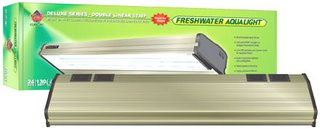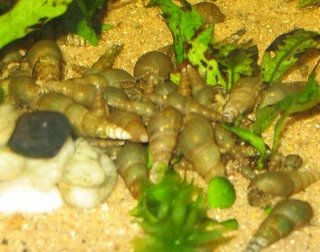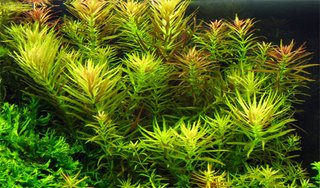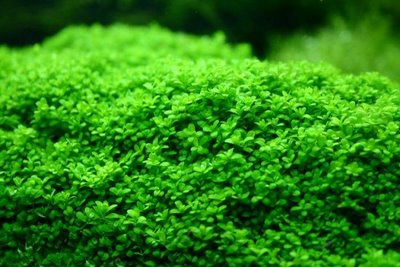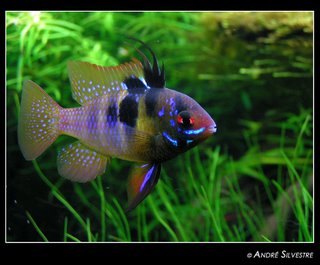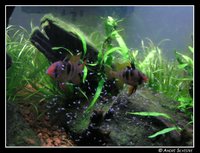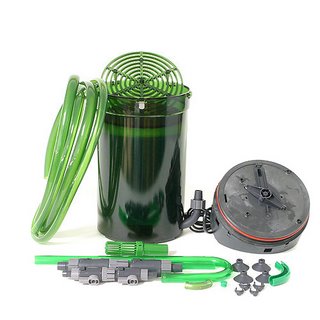
The Eheim 2217 is the largest of the Classic series you can buy. It's rated at 264 gallons per hour and the filter itself is a hefty 6 liters (roughly 1.5 gallons). This is significant because the volume of the filter container determines how much media you can put in and the more media, the more filtering capacity. Many people mistakenly think that the flow is what determines what size tank a filter can handle. Although this holds true in some cases, larger filter volume will always mean larger filtering capacity. It doesn't matter how fast you push water through a tiny container, it will only have so much media that can do the job. Although the 159 gallon rating may be a bit optimistic (like the 2213's 66 gallon rating), this filter can certainly get the job done on any tank below its upper limit.
If anyone asks you why an Eheim is one of the best filters available today, you can point to the flawless German engineering and efficiency. The 2217 only uses 20 watts to push all that flow; comparable filters use 25 or more. There is also absolutely no bypass. The way the filter is designed means that all water must pass through the media. Any dirt that gets sucked up by this filter remains in the filter.
 The quality of the parts and construction is top notch. When you clamp the lid onto the container, you know it wouldn't leak, ever. Not even if you tried. In fact, you can even run it without half the clamps and it still won't leak. Priming the 2217 for the first time can be a bit of an ordeal (like any of the Classic series). These filters don't come with any of the fancy self-priming buttons or levers, but they do come with double-tap valves, which make all the difference. However, the first time you set it up, you will funnel (Eheim sells a bulb to do this) or, with much regret, suck on the intake tube. Once you have it filled and running, all you have to do is close the valves on the double-tap connectors, unplug the filter, then separate the connectors. The water remains in the tubing and in the filter, so when you're finished, just reconnect everything, open up the valves, and turn it on. No priming ever again!
The quality of the parts and construction is top notch. When you clamp the lid onto the container, you know it wouldn't leak, ever. Not even if you tried. In fact, you can even run it without half the clamps and it still won't leak. Priming the 2217 for the first time can be a bit of an ordeal (like any of the Classic series). These filters don't come with any of the fancy self-priming buttons or levers, but they do come with double-tap valves, which make all the difference. However, the first time you set it up, you will funnel (Eheim sells a bulb to do this) or, with much regret, suck on the intake tube. Once you have it filled and running, all you have to do is close the valves on the double-tap connectors, unplug the filter, then separate the connectors. The water remains in the tubing and in the filter, so when you're finished, just reconnect everything, open up the valves, and turn it on. No priming ever again! 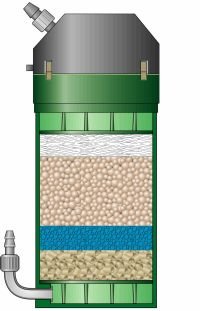 My 2217 came with free media, as I think most do at this point. It came with 1 fine pad, 1 coarse pad, 1 carbon pad, Ehfimech, and Ehfisubstrat Pro. These are all top notch, and the Ehfisubstrat Pro is specially shaped so it doesn't compact and clog. They provide mechanical, biological, and chemical filtration. Again, nothing gets by this media. It also came with tubing and tubing accessories including a spraybar, an intake tube with strainer, and suction cups. It includes a plastic elbow piece which I believe is an alternative to the sparybar, but quite frankly, if you decided to use it it'd be like putting a fire hose in your tank; heaven help the poor fish who unknowingly swims in front of it.
My 2217 came with free media, as I think most do at this point. It came with 1 fine pad, 1 coarse pad, 1 carbon pad, Ehfimech, and Ehfisubstrat Pro. These are all top notch, and the Ehfisubstrat Pro is specially shaped so it doesn't compact and clog. They provide mechanical, biological, and chemical filtration. Again, nothing gets by this media. It also came with tubing and tubing accessories including a spraybar, an intake tube with strainer, and suction cups. It includes a plastic elbow piece which I believe is an alternative to the sparybar, but quite frankly, if you decided to use it it'd be like putting a fire hose in your tank; heaven help the poor fish who unknowingly swims in front of it. Eheims are probably the best filters you can buy, if you have the money. The 2217 usually retails for around $150 but is well worth it, as these filters have been known to last for decades. I give it five out of five fish:
Pros: Efficient, high quality, no bypass, large filtration capacity
Cons: First time priming can leave a fishy taste in your mouth
Buy the Eheim Classic Canister 2217 now at Drs. Foster & Smith.


